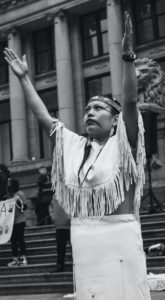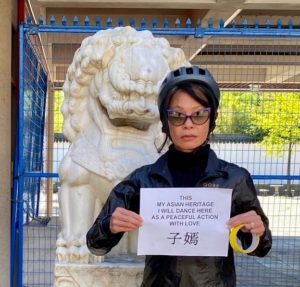Life Moves: Dancing solidarity in the streets - Vancouver Ballet Society
- Home
- Life Moves
- Life Moves: Dancing solidarity in the streets

By Tessa Perkins Deneault
Many current events seem to demand creative action. Dancers are responding by performing at protests, staging their own peaceful interventions or using dance as a way to draw attention to their causes. Dance as protest isn’t a new phenomenon, of course. Dance has long played a role in providing social commentary on current issues. But what happens when that social commentary moves from the realm of formal concert performances to the streets? In that setting, dance can act as a powerful form of activism, with the recent examples below demonstrating how it can advance social causes, raise awareness, and allow for emotional release and healing.

Lorelei Williams is one of Canada’s most vocal advocates for missing and Indigenous women, a national tragedy that has been described as a genocide. She was looking for a way to raise awareness of violence against Indigenous women and girls when, in 2012, she founded Butterflies in Spirit and assembled a dance troupe whose members wear t-shirts showing faces of lost relatives to honour their memories.
In their first performance, Butterflies in Spirit shut down a major intersection in Vancouver and danced to Beyoncé’s Run the World (Girls). At the end of the piece, those who had lost loved ones lay on the pavement and white sheets were placed over them. Since then, they have performed at events in Canada, the United States, Mexico and Colombia.
Gurdeep Pandher, a bhangra dancer from the Yukon, is known for posting videos of himself on social media dancing in beautiful outdoor locations, sometimes with community members. In July, he lent his energy to a protest in Whitehorse, on the lawn outside a government building, where teachers and students were demanding that the Department of Education keep the Music, Arts and Drama program in the same school where it has a dedicated space and is part of an alternative experiential learning program.

Dance artist Ziyian Kwan, the artistic director of Dumb Instrument Dance in Vancouver, organized a peaceful dance action at the city’s Chinese Cultural Centre in May as a response to the rise in anti-Asian racism in the wake of the COVID-19 pandemic. The cultural centre was defaced with racist graffiti in April, and Kwan — a Canadian of Asian heritage — was a victim of a racist verbal attack while planning the event. This isn’t Kwan’s first foray into dance as protest. In 2010, along with a group of colleagues, she staged a series of dance busking sessions to raise awareness of cuts to arts funding.
Black Lives Matter protests in response to the killing of George Floyd by Minneapolis police have included many examples of dance both locally and around the world. Whether planned or spontaneous, dance adds power to the participants’ various expressions of frustration, determination, pride and resilience.
On June 7, a group assembled in Harlem, New York, for “Dance for George” to perform the electric slide and raise awareness of black artists in the dance and entertainment industries. Also in June, protesters in New Zealand performed the haka, a ceremonial Māori dance, outside the US Consulate. Other recent examples include multiple occasions of the Cupid Shuffle and Cha Cha Shuffle, spontaneous dance jams in Portland, a dance party in New Orleans, vogue in Chicago, a dance rally in Salt Lake City, street dance in Toronto, a hip-hop cypher in New York, and Bomba in Puerto Rico, a traditional dance representing the island’s African heritage. The occasions of dance being incorporated in recent protests are so numerous that hip-hop dancer and researcher MiRi Park has compiled a long list in a public Google document.
Indigenous dancers in Minneapolis also responded in solidarity with Black Lives Matter. A group of jingle dress dancers, with vocals and drumming from the RedBone Singers, circled the memorial at the intersection where Floyd lost his life.
Whether as an act of solidarity, resistance, activism or celebration, dance allows protesters to come together in the physical embodiment of a shared goal and reach a broad audience. No matter the cause, our messages are stronger when we move in unison.

